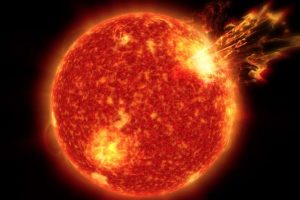A new study as per a report in sciencealert.com suggests that following the cataclysmic asteroid strike on the Earth, 66 million years ago, the dinosaurs and other beings who survived had to go through the terrible ordeal of suffering high content of sulphur.
The sulphur which had been thrown high into the stratosphere had drastic consequences as it blocked the Sun leading to cooling of the planet for centuries with fatal acid rain falling on the Earth, altering the oceans chemistry for a period spanning thousands of years. This was contrary to what was thought of earlier by scholars.
Talking about the findings of the study, the study’s co-researcher, James Witts, observed, “we've underestimated the amount of this sulphur that this asteroid impact created”.
Witts, who is a lecturer at the United Kingdom’s University of Bristol, School of Earth Sciences, added that as a consequence of this, "the climate change that was associated with it was much greater perhaps than we thought previously".
The presence of this large quantity of sulphur does go to throw light on why it took a long time for life, especially the one in the marine sphere, to stage come back. The sulphur that fell on land would have reached the oceans too, according to Witts.
The discovery by the scientists about the sulphur was quite unexpected. The original objective of the team was to study ancient shells’ geochemistry that were found near the Brazos river in Falls County, Texas. A distinctive feature of this place is that it was underwater in the period when non-avian dinosaurs vanished at the end of the Cretaceous era.
Significantly, this place is quite close to the Chicxulub crater in Yucatan Peninsula, Mexico which was hit by a 10-kilometres-wide asteroid.
The samples of the sediment taken by the scientists were taken to Scotland’s University of St. Andrews, where the co-researcher of the study, Aubrey Zerkle, looked at the different sulphur isotopes.
This analysis of the sulphur isotopes revealed “a very unusual signal” – tiny changes in their masses which take place when sulphur enters the atmosphere and interacts with ultraviolet light.
Explaining this, Witts said: “That can really only happen in two scenarios: either in an atmosphere that doesn't have any oxygen in it or when you have so much sulphur, it's gone really high up into an oxygenated atmosphere.” Incidentally, the Earth has been encircled by an oxygenated atmosphere from 2.3 billion years ago.
He went on to add: "You don't see [this signal] in marine rocks. The sea has its own isotopic signature which totally dilutes the tiny amount of sulphur from these volcanoes."
The presence of this signal in marine rocks belonging to the Cretaceous period, Witts said points that "there must have been a heck of a lot of sulphur in the atmosphere after this impact event. And that, of course, has a huge implication for climate change related to the impact because sulphur aerosols, we know from modern volcanic eruptions, cause cooling."
A lot of this sulphur came from the limestone in the Yucatan Peninsula which was rich in sulphur. This is significant as Witts pointed out: "If the asteroid had hit somewhere else, perhaps there wouldn't have been as much sulphur released into the atmosphere and the climate change that followed might not have been as severe. And therefore, the extinction event might not have been so bad."
Estimates in the past suggested that the sulphur which would have turned into sulphate aerosols would have resulted in cooling of the Earth for a few decades ranging from 2 to 8 degrees Celsius. Now, with the latest study pegging the sulphur amount higher, the change in climate would have been acute.
Details of the study were published online in the Proceedings of the National Academy of Sciences journal.




















